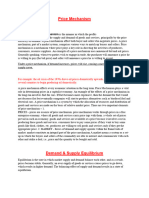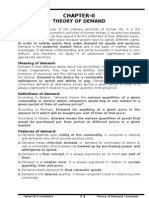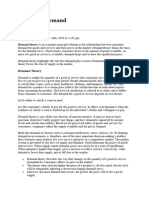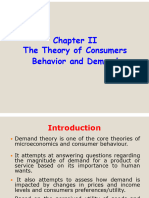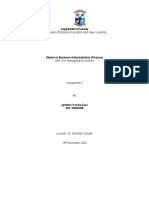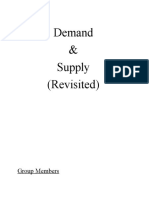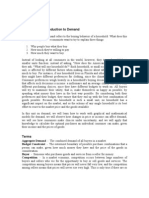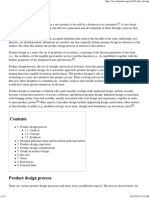Determination D&s
Determination D&s
Uploaded by
rajatrtmCopyright:
Available Formats
Determination D&s
Determination D&s
Uploaded by
rajatrtmOriginal Title
Copyright
Available Formats
Share this document
Did you find this document useful?
Is this content inappropriate?
Copyright:
Available Formats
Determination D&s
Determination D&s
Uploaded by
rajatrtmCopyright:
Available Formats
Demand, Supply and Market Price Determination
Consumer behaviour Utility is the economists term for the satisfaction a customer derives from the goods that they buy. Marginal utility is the increase in total utility arising from an increase in consumption by one more. For example, suppose I like eating bananas, and I have already eaten one banana; then the satisfaction I get from consuming a second banana is called by economists the marginal utility. Marginal utility is the utility gain from the consumption of one more item. Basically, economists are assuming that people derive satisfaction from the consumption of goods in general, and that people seek to consume as much as they can within their budget. However, the Law of diminishing marginal utility states that the rate at which total utility rises diminishes as consumption of a good increases and that eventually there will be negative marginal utility. To explain this, imagine eating bananas. The first banana is delicious. Already, by the time you reach the second banana your hunger has been partially satisfied, and although the second banana is also delicious, it does not give as much satisfaction as the first. Nonetheless, the satisfaction is still positive, so total utility is still rising. However, by the time you get to your tenth banana you may be feeling sick of bananas, and sooner or later, as you consume more and more of a good, you will less and less satisfaction from it.
Price as a measure of utility The price that we are prepared to pay for a good is related to the satisfaction we gain from it. Say one has a choice between two goods, both of which yield the same utility on consumption. Then it makes no sense to pay more for one of the goods than for the other. Thus, price is thought to be proportional to utility for each individual person. The Optimum position for a consumer is when he or she maximizes his satisfaction (his utility) for a given fixed income. Consumers distribute their expenditures among all available commodities until the last penny spent on each commodity yields the same marginal utility. The theory of consumer behaviour assumes that (a) consumers want to maximize their satisfaction, as measured by utility; (b) know what satisfaction they derive from each good and can compare them; (c) are rational in their decision making.
Copyright Blacksacademy April 2003
What all of this means is that we can assume that the decisions people make about how much to pay for a good are closely related to how much satisfaction they derive from it.
Market A market is any mechanism, formal or informal, institutional or not, whereby buyers and sellers can communicate with each other to buy and sell a commodity. A market could be literally an open space of ground where sellers set up stalls and purchases walk around to view and buy the goods. However, many goods are now bought and sold via the Internet, so this provides another market.
Effective demand Effective demand is the demand for a good that customers are able and willing to back with money. What this means is that merely wishing to have a good is not effective demand. For the wish to turn into demand in the economists sense, the person with the wish must be prepared to part with his cash in order to fulfil it at least at some price or other. Effective demand is also demand per unit of time. What this means is, for example, is the number of bananas consumed per week. This might be doubled if the time period was doubled to two weeks. But it is usual to refer to the quantity demanded per unit of time as simply quantity. It is also usual to refer to effective demand as simply demand.
Demand curve A demand curve is a graphical representation of the relationship between effective demand (or just demand) and price. The idea of a demand curve is intuitively clear, but strictly speaking it is the result of adding up the individual demand schedules for each persons consumption of a good. A demand schedule specifies how much a good a person will purchase at a given price. For example, one might buy six bananas a week at 20p per banana but only three at twice that price. Then, to achieve the total demand curve for bananas, one needs to add up the demand for bananas of every individual to obtain the demand for bananas for the market as a whole.
Copyright Blacksacademy April 2003
Price
Demand Quantity demanded per unit of time
The downward slope of the demand curve reflects the law of diminishing marginal utility. Economists generally assume that individuals get less and less satisfaction from consuming more and more of a given good. Hence, they conclude that an individuals demand for a good will fall with price. Thus, it is expected that the demand for a good will be downward (or negatively) sloping. We tend to represent the demand for a good by a straight line in our graphs. But there is no necessary reason why the relationship should follow a straight-line graph (we say should be linear). The demand could take any number of shapes for instance
Price
D
Quantity
Note also that here we have abbreviated demand per unit of time to just demand, and used the symbol D to represent the demand curve.
Copyright Blacksacademy April 2003
Normal goods In fact, not all goods do have negatively sloped demand curves, so those that do are called normal goods.
Properties of the demand curve A change in price does not affect the position of the demand curve. The demand curve describes the relationship between price and demand. On the other hand, any other changes that can affect the demand for a good will affect the position and/or slope of the demand curve. In graphical terms this could mean that the demand curve will shift to the right or shift to the left. Since a shift to the right means that more of the good is demanded at every price, this is called an improvement in the conditions of demand.
Price
D* D
Quantity
An improvement in the conditions of demand leads to a shift to the right of the demand curve from D to D*.
Supply Supply works in a similar way to demand. It is assumed that suppliers seek to maximise profits. The higher the price of a good, the easier it is to make a profit. Consequently, suppliers will offer more and more of a good to the market as the price goes up. Thus, under normal conditions, the supply of a good will increase as the price increases. Supply is also strictly speaking supply per unit of time; although it is customary to omit this when referring to supply.
Copyright Blacksacademy April 2003
Price
Supply
Quantity
Interaction of supply and demand When the market is working perfectly, so that everyone knows exactly how much is going to be supplied at a given price, and how much is going to be demanded at a given price, the rational and logical conclusion is that the quantity supplied to the market will be exactly the same as the quantity demanded, and that the price the goods are supplied at will be the same as the price that they sell at. Suppliers will ask exactly what customers are prepared to pay at the equilibrium level of quantity. This leads to a simple graphical representation of the market.
Price
Equilibrium Price
D
Equilibrium Quantity
Quantity
Copyright Blacksacademy April 2003
This assumes that the market operates perfectly. However, in practice markets may not be perfect, and some mismatch between supply and demand can take place. At a given time there may be more goods brought to the market and offered at such a price that not all of them are taken up by customers. This leads to what are called dynamic considerations of the interaction of supply and demand. The term dynamic is used to describe how anything is affected by the passage of time. We would consider the question of how long it takes for a market to reach equilibrium. A market could be sluggish or volatile. A market could be such that it never reaches equilibrium. This also leads to an advanced topic known as cobweb analysis, which describes how fluctuations in the market price and quantity demanded arise from delays between how supply is fixed at a given time. However, consideration of this topic only complicates matters, and for the present we will ignore it, and assume that the market is perfect a hence that any changes in demand nd or supply lead immediately to changes in the equilibrium price.
Changes in the conditions of demand or supply Changes in the conditions of demand or supply lead to changes in the equilibrium price and quantity demand. The graphs make this quite clear.
Price
S P' P D* D Q Q'
Quantity
An improvement in the conditions of demand leads to an outward shift of the demand curve. This causes the price of the good to increase from P to P and the quantity demanded to increase from Q to Q .
Copyright Blacksacademy April 2003
You might also like
- Assignment V 1.0Document5 pagesAssignment V 1.0Ali MurtazaNo ratings yet
- A level Economics Revision: Cheeky Revision ShortcutsFrom EverandA level Economics Revision: Cheeky Revision ShortcutsRating: 3 out of 5 stars3/5 (1)
- Case3 Southwest AirlinesDocument1 pageCase3 Southwest AirlinesAmalraj PampanalNo ratings yet
- CargillsDocument14 pagesCargillsAnonymous 0HycR5360% (5)
- Project ReportDocument41 pagesProject Reportsarthakzz50% (2)
- Sample Business PlanDocument42 pagesSample Business PlanAfini Zulkifli50% (2)
- Chapter 2 Demand and SupplyDocument34 pagesChapter 2 Demand and SupplyAbdul-Mumin AlhassanNo ratings yet
- Inferior Goods-A Product That's Demand Is Inversely Related To Consumer Income. in Other WordsDocument5 pagesInferior Goods-A Product That's Demand Is Inversely Related To Consumer Income. in Other WordsJasmine AlucimanNo ratings yet
- Law of Demand: Key PointsDocument7 pagesLaw of Demand: Key PointsFalah SohailNo ratings yet
- WR Group3Document22 pagesWR Group3Feane LamasanNo ratings yet
- Reflection Paper in Micro-Economics - MingoyDocument23 pagesReflection Paper in Micro-Economics - MingoyRochelle BustaliñoNo ratings yet
- Microeconomics. Ch.2Document51 pagesMicroeconomics. Ch.2Arif LadlaNo ratings yet
- Applied Economics: Module No. 3: Week 3: First QuarterDocument12 pagesApplied Economics: Module No. 3: Week 3: First QuarterGellegani, Julius0% (1)
- Managerial Economics: Ii: Demand and SupplyDocument74 pagesManagerial Economics: Ii: Demand and Supplykewani negashNo ratings yet
- Law of Supply and DemandDocument6 pagesLaw of Supply and DemandArchill YapparconNo ratings yet
- Ch. 3 Demand AnalysisDocument10 pagesCh. 3 Demand AnalysisJeegar BhattNo ratings yet
- Managerial EconomicsDocument24 pagesManagerial EconomicsRudydanvinz BernardoNo ratings yet
- Seminar 2 - Demand and Supply - ADocument12 pagesSeminar 2 - Demand and Supply - Avivekrabadia0077No ratings yet
- Bam 040 Demand and Supply PT.2Document14 pagesBam 040 Demand and Supply PT.2Vkyla BataoelNo ratings yet
- ApplEcon Module 1Document10 pagesApplEcon Module 1Alec FranciscoNo ratings yet
- Economics Chapter 2 14Document84 pagesEconomics Chapter 2 14Jarren BasilanNo ratings yet
- Chapter 3Document6 pagesChapter 3LLLLL MMMMMNo ratings yet
- Managerial Economics - Module - 2Document30 pagesManagerial Economics - Module - 2Eswar RajNo ratings yet
- Managerial Economics Module 2 1Document35 pagesManagerial Economics Module 2 1Eswar RajNo ratings yet
- Ae Week 5 6 PDFDocument26 pagesAe Week 5 6 PDFmary jane garcinesNo ratings yet
- Official Soft Copy ReportDocument54 pagesOfficial Soft Copy ReportJayson Berja de LeonNo ratings yet
- UntitledDocument10 pagesUntitledCKEC-CSE IVNo ratings yet
- Bacc 1 Basic Microeconomics: Davao Central College, IncDocument11 pagesBacc 1 Basic Microeconomics: Davao Central College, IncMickeyNo ratings yet
- Applied Economics 2Document49 pagesApplied Economics 2porkbellygrilledNo ratings yet
- Law of Supply and DemandDocument49 pagesLaw of Supply and DemandArvi Kyle Grospe PunzalanNo ratings yet
- Module App-Econ 03Document8 pagesModule App-Econ 03Ashley TobatsNo ratings yet
- Presentación 17Document24 pagesPresentación 17melany dayanaNo ratings yet
- Demand Analysis PDFDocument35 pagesDemand Analysis PDFSaransh AgarwalNo ratings yet
- Managerial Economics - Midterm Exam ReviewDocument10 pagesManagerial Economics - Midterm Exam Reviewdyan.ensoNo ratings yet
- Document From Hassan RazaDocument14 pagesDocument From Hassan RazaAli RazaNo ratings yet
- Law of Supply and DemandDocument18 pagesLaw of Supply and DemandArnee Pantajo83% (6)
- Business Economics BCADocument25 pagesBusiness Economics BCAamjoshuabNo ratings yet
- DEMAND ANALYSIS Meaning of Demand AnalysisDocument5 pagesDEMAND ANALYSIS Meaning of Demand AnalysiskiranluckyNo ratings yet
- ChapterII Theory of Demand and Supply1Document29 pagesChapterII Theory of Demand and Supply1VirencarpediemNo ratings yet
- Chap 3Document2 pagesChap 31st BackupNo ratings yet
- Managerial Economics Ch3Document67 pagesManagerial Economics Ch3Ashe BalchaNo ratings yet
- Part - 2Document46 pagesPart - 2Seid AragawNo ratings yet
- Me Unit 2Document21 pagesMe Unit 2biswajeet2580No ratings yet
- Me 2Document79 pagesMe 2animut silesheNo ratings yet
- Chapter 2.1 SupplyandDemand - #2Document9 pagesChapter 2.1 SupplyandDemand - #2Mark Ogie PasionNo ratings yet
- Microeconomics Notes For BeginnersDocument31 pagesMicroeconomics Notes For Beginnerssalmanahmed_hyd100% (3)
- Activity 81000Document9 pagesActivity 81000Mary Grace NayveNo ratings yet
- ECONOMICSDocument25 pagesECONOMICSJotham ShumbaNo ratings yet
- Ae Module 2Document2 pagesAe Module 2Janine BalcuevaNo ratings yet
- Eco AssignmentDocument8 pagesEco Assignmentyashchy0707No ratings yet
- Demand TheoryDocument21 pagesDemand TheoryGM BalochNo ratings yet
- Poe AzimDocument22 pagesPoe AzimsyarifNo ratings yet
- Assingment #4Document11 pagesAssingment #4kaszulu1No ratings yet
- Course Lesson ThreeDocument14 pagesCourse Lesson Threeyng guesNo ratings yet
- Demand and SupplyDocument13 pagesDemand and Supplymafiawars21No ratings yet
- Demand AnalysisDocument42 pagesDemand AnalysisTejas PatilNo ratings yet
- Demand PDFDocument13 pagesDemand PDFTanvirNo ratings yet
- ECONDEVDocument8 pagesECONDEVAyiNo ratings yet
- Chapter 2: Application of Demand and SupplyDocument9 pagesChapter 2: Application of Demand and SupplyAjilNo ratings yet
- Demand: Summary and Introduction To DemandDocument22 pagesDemand: Summary and Introduction To DemandUmer EhsanNo ratings yet
- O'Sullivan, Arthur Sheffrin, Steven M. (2003) .Economics: Principle in Action. Upper Saddle River, New Jersey: Pearson Prentice Hall. P .79Document3 pagesO'Sullivan, Arthur Sheffrin, Steven M. (2003) .Economics: Principle in Action. Upper Saddle River, New Jersey: Pearson Prentice Hall. P .79Malvika BishtNo ratings yet
- Objectives For Chapter 3: Demand and SupplyDocument23 pagesObjectives For Chapter 3: Demand and SupplyAnonymous BBs1xxk96VNo ratings yet
- Unit 2-Demand AnalysisDocument10 pagesUnit 2-Demand Analysiskunal kashyapNo ratings yet
- Demand and Supply Law of DiminishingDocument6 pagesDemand and Supply Law of DiminishinggralenekovaNo ratings yet
- Mastering the 15 Laws of Business and Life: Navigating Success through Timeless PrinciplesFrom EverandMastering the 15 Laws of Business and Life: Navigating Success through Timeless PrinciplesNo ratings yet
- ECON2101 Final NotesDocument12 pagesECON2101 Final NotesrubyNo ratings yet
- TBCH 12Document16 pagesTBCH 12bernandaz123No ratings yet
- Competition Act PPT 1Document15 pagesCompetition Act PPT 1Emy Mathew100% (1)
- IB Economics-Internal Assessment Cover SheetDocument8 pagesIB Economics-Internal Assessment Cover SheetJacob AronovitzNo ratings yet
- Ryabella Resume 2014 v2 1Document9 pagesRyabella Resume 2014 v2 1api-251881014No ratings yet
- Calvin KlienDocument5 pagesCalvin KlienVarun MehrotraNo ratings yet
- Unit I-Consumer HealthDocument61 pagesUnit I-Consumer HealthJhon Antonio AbadNo ratings yet
- AmazonDocument6 pagesAmazonOdontamir ErdenebalNo ratings yet
- "Customer Preferences Towards" Goodyear V/S Apollo Tyres: Project Report ONDocument87 pages"Customer Preferences Towards" Goodyear V/S Apollo Tyres: Project Report ONridhsiNo ratings yet
- Report On Industrial Attachment at Abanti Colour Tex LimitedDocument119 pagesReport On Industrial Attachment at Abanti Colour Tex LimitedAbu Hasnat Md. Shakik ProdhanNo ratings yet
- Mankiw9e Lecture Slides Chap02Document56 pagesMankiw9e Lecture Slides Chap02BahramNo ratings yet
- HP Company Laptop Survey TopicDocument3 pagesHP Company Laptop Survey TopicShaikh AsifNo ratings yet
- Management of Sales Territories and QuotasDocument27 pagesManagement of Sales Territories and QuotasVikasNo ratings yet
- Material Self: Consumer Culture and ConsumerismDocument2 pagesMaterial Self: Consumer Culture and ConsumerismAngelo Chan100% (2)
- Tourism Market Segmentation - ReviewerDocument2 pagesTourism Market Segmentation - ReviewerAdrian MarananNo ratings yet
- The Consumer Protection Act 1986Document4 pagesThe Consumer Protection Act 1986Shivarajkumar JayaprakashNo ratings yet
- American Apparel ProjectDocument29 pagesAmerican Apparel ProjectTahmid Sadat100% (1)
- 507-Veena PDFDocument9 pages507-Veena PDFSumathi LoganathanNo ratings yet
- Entrep - Target Market HandoutDocument1 pageEntrep - Target Market HandoutM BuenaNo ratings yet
- Business Plan: Bulacan Ecumenical SchoolDocument16 pagesBusiness Plan: Bulacan Ecumenical SchoolNikkinicole Jawod CubitaNo ratings yet
- Features of The Restaurant Business.Document34 pagesFeatures of The Restaurant Business.Smruti AlinjeNo ratings yet
- Technology in BankingDocument1 pageTechnology in BankingkaanthikeerthiNo ratings yet
- E2 Case Study LenovoDocument5 pagesE2 Case Study LenovoAna M Ayala Zaldaña100% (1)
- Apple Inc.'s Proposed Findings of FactDocument80 pagesApple Inc.'s Proposed Findings of FactSapodriloNo ratings yet
- Product Design - WikipediaDocument5 pagesProduct Design - Wikipediakirthi83No ratings yet




































